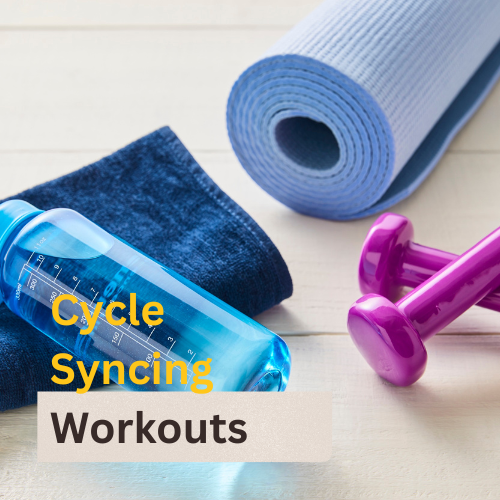Table of Contents
Cycle Syncing Workouts: Aligning Fitness with Your Menstrual Cycle
In recent years, health and wellness trends have increasingly embraced personalized approaches—and cycle syncing workouts are at the forefront of this movement in 2025. This innovative fitness method aligns exercise routines with the phases of the menstrual cycle, optimizing energy levels, hormone balance, and overall well-being for people who menstruate.
This blog explores the science behind cycle syncing, how to implement it, benefits, popular workout types by phase, and why it’s gaining momentum as a sustainable fitness practice.
What is Cycle Syncing?
Cycle syncing involves adjusting your diet, exercise, and lifestyle habits to correspond with the four phases of the menstrual cycle:
- Menstrual Phase (Days 1–5): This is the time when your body sheds the uterine lining. Energy levels may be lower, and you might feel the need for rest.
- Follicular Phase (Days 6–14): During this phase, your hormones begin to rise, which increases energy, motivation, and the body’s readiness for more intense workouts.
- Ovulation Phase (Days 15–17): This is when you typically feel your best. Peak strength and endurance are possible during ovulation, making it an ideal time for high-intensity exercise.
- Luteal Phase (Days 18–28): Energy levels start to decline as your body prepares for menstruation again. This phase is ideal for moderate-intensity workouts.
Tailoring workouts to these phases helps you work with your body’s natural cycles rather than against them.
The Science Behind Cycle Syncing
The key to cycle syncing is understanding how the different phases of the menstrual cycle impact the body’s physiology. Let’s break it down:
1. Menstrual Phase: A Time for Rest and Recovery
The first phase of your cycle is marked by menstruation, where the uterine lining sheds, and your body experiences a dip in estrogen and progesterone levels. As a result, you may feel more fatigued and less inclined to engage in intense physical activity.
- Why It’s Ideal for Rest: This is the body’s natural time to rest, heal, and replenish its energy stores. By reducing the intensity of your workouts during this phase, you allow the body to recover, preventing overtraining and injury.
- Recommended Activities: Gentle exercises like yoga, walking, stretching, and Pilates are perfect for this phase. These low-impact activities allow your body to recover while still keeping you active.
2. Follicular Phase: Energizing the Body for Strength and Endurance
As estrogen levels rise during the follicular phase, so does your body’s energy and strength. Estrogen positively influences muscle recovery, endurance, and overall exercise performance.
- Why It’s Ideal for Strength Building: With rising estrogen levels, you’ll find that your strength and endurance are higher. This phase provides a prime opportunity to push yourself in strength training and high-intensity interval training (HIIT).
- Recommended Activities: Strength training, HIIT, and cardiovascular workouts are ideal during this phase. It’s a time when your body can handle more intensity and stress, improving endurance and building muscle.
3. Ovulation Phase: Peak Performance
Ovulation marks the peak of your hormonal cycle, characterized by high levels of estrogen, which support muscle strength and recovery. This is the time when your energy levels are at their highest, and your body is at its peak.
- Why It’s Ideal for High-Performance Workouts: During this phase, women often experience peak strength and coordination, making it an ideal time to engage in high-intensity activities and performance-based exercises.
- Recommended Activities: Competitive sports, sprinting, powerlifting, and explosive movements like plyometrics are excellent for this phase. Your body is capable of handling high-intensity training, so it’s the time to push your limits and reach new performance benchmarks.
4. Luteal Phase: Balancing Energy and Fat Burn
The luteal phase is marked by a decrease in estrogen levels and a rise in progesterone. These changes often lead to a decline in energy levels as your body begins to prepare for menstruation. During this phase, it’s crucial to maintain a balanced approach to your fitness routine.
- Why It’s Ideal for Moderate Workouts: As energy levels gradually decline, it’s important to switch to more moderate-intensity exercises to avoid burnout. The body’s focus shifts from strength and endurance to maintaining balance and fat burning.
- Recommended Activities: Moderate-intensity workouts like steady-state running, cycling, and barre are ideal during the luteal phase. These exercises can help maintain cardiovascular health, burn fat, and promote overall well-being.
Cycle Syncing and PCOS
Polycystic Ovary Syndrome (PCOS) is a common hormonal disorder that can affect menstrual cycles, fertility, and overall health. Interestingly, cycle syncing can be particularly beneficial for individuals with PCOS. By aligning exercise routines with the natural fluctuations of hormones throughout the menstrual cycle, those with PCOS may experience improved hormonal balance, better insulin sensitivity, and enhanced reproductive health.
For more information on how to manage PCOS through lifestyle changes, including exercise and diet, check out our comprehensive guide on PCOS: Understanding Symptoms & Effective Treatment.
Scientific Backing for Cycle Syncing Workouts
Studies suggest that cycle syncing workouts optimize the body’s ability to build strength, endurance, and recovery. Hormonal fluctuations impact muscle strength, endurance, and recovery speed, which is why listening to your body’s needs during different phases is essential.
Research from Harvard Health Publishing emphasizes the link between hormonal balance and exercise performance. During perimenopause and menopause, the need for tailored fitness programs that support hormonal changes is more crucial than ever.
By syncing your workouts with your menstrual cycle, you are not only optimizing your training but also preventing overtraining and promoting better recovery.
Getting Started with Cycle Syncing Workouts
To begin incorporating cycle syncing workouts into your fitness routine, follow these steps:
1. Track Your Cycle
Use cycle-tracking apps like Clue, Flo, or Ovia to track your menstrual cycle. These apps can help you pinpoint which phase you’re in, allowing you to tailor your workouts to each phase’s unique energy levels.
2. Plan Weekly Workouts
Plan your weekly workouts by considering which phase of your cycle you are in. For example, during the follicular and ovulation phases, plan for more intense workouts, while during the menstrual and luteal phases, aim for gentler, restorative exercises.
3. Listen to Your Body
Cycle syncing is about listening to your body’s signals and adjusting workouts accordingly. If you feel fatigued or unmotivated, it might be best to reduce the intensity of your workouts and prioritize rest or low-intensity exercises.
4. Consult Professionals
Work with personal trainers or health coaches who understand cycle syncing workouts. They can help tailor a fitness plan that best suits your individual needs and goals.
Popular Workouts by Phase
Menstrual Phase (Days 1–5)
During menstruation, focus on low-intensity exercises such as:
- Yoga (gentle or restorative styles)
- Walking
- Pilates
- Stretching or foam rolling
This phase is ideal for recovery and relaxation. Engage in activities that promote healing without overexertion.
Follicular Phase (Days 6–14)
As your energy levels rise, aim for more intense and strength-focused exercises:
- Strength training (free weights, resistance bands)
- HIIT (High-intensity interval training)
- Cardio (running, cycling, rowing)
This is a great time to challenge yourself and experiment with new exercises.
Ovulation Phase (Days 15–17)
With peak strength, this phase is perfect for maximum effort:
- Powerlifting
- Competitive sports (soccer, basketball)
- Plyometrics (jumping exercises, sprints)
Push yourself to the limit during this phase to maximize muscle performance.
Luteal Phase (Days 18–28)
As energy levels gradually decline, switch to moderate-intensity exercises that promote fat burning and flexibility:
- Steady-state running
- Cycling
- Barre or yoga
- Swimming or light cardio
This phase is about maintaining your fitness while respecting your body’s need for rest.
Cycle Syncing and Nutrition
Nutrition plays a significant role in maximizing the benefits of cycle syncing. Adjust your diet to support each phase of your cycle by focusing on nutrient-rich foods that aid in hormonal balance, energy production, and muscle recovery.
For example:
- Follicular Phase: High-protein foods, healthy fats, and complex carbs to support energy levels and muscle growth.
- Ovulation Phase: Nutrient-dense foods rich in antioxidants to support peak performance and immunity.
- Luteal Phase: Magnesium-rich foods to alleviate PMS symptoms and support mood regulation.
The Future of Cycle Syncing Workouts in 2025
In 2025, cycle syncing workouts are gaining even more popularity as the wellness community continues to embrace personalized approaches to fitness. This trend is empowering individuals to honor their bodies’ natural rhythms, fostering greater well-being, and encouraging more sustainable fitness practices.
As more research emerges to support cycle syncing’s benefits, it is likely to become a mainstream fitness strategy, offering a personalized approach that supports not just physical health but emotional well-being too.
Conclusion: Embracing Cycle Syncing Workouts for Better Health
Cycle syncing workouts represent a significant shift toward personalized fitness. By aligning your exercise routine with your menstrual cycle, you can improve performance, balance hormones, and enhance overall well-being. This holistic approach to fitness will continue to thrive in 2025 and beyond, offering a sustainable and mindful way to stay active.
External Resources:
- Harvard Health Publishing – Cycle Syncing
- Women’s Health Magazine – Menstrual Cycle and Exercise
- Mayo Clinic – Perimenopause and Menopause
Frequently Asked Questions About Cycle Syncing Workouts
1. What is cycle syncing?
Cycle syncing is the practice of adjusting your diet, exercise, and lifestyle habits to align with the four phases of the menstrual cycle. This method optimizes energy levels, hormone balance, and overall well-being by tailoring activities to the body’s natural rhythms.
2. How do the phases of the menstrual cycle affect exercise?
Each phase of the menstrual cycle influences hormone levels, which in turn affect energy, strength, and endurance.
- Menstrual Phase (Days 1–5): Energy is typically lower; focus on rest and gentle activities.
- Follicular Phase (Days 6–14): Rising hormones increase energy and strength, making it ideal for strength training and intense cardio.
- Ovulation Phase (Days 15–17): Peak strength and endurance, perfect for high-intensity workouts.
- Luteal Phase (Days 18–28): Energy decreases as you near menstruation; moderate-intensity workouts are ideal.
3. How can I benefit from cycle syncing?
By aligning your workouts with your cycle, you can maximize workout effectiveness during high-energy phases and support recovery during low-energy phases. This approach can also help with hormone balance, mood regulation, and maintaining motivation and consistency.
4. Can I sync my workouts if my cycle is irregular?
Yes, cycle syncing can be adapted to irregular cycles. Apps like Clue and Flo can help you track your cycles and adjust workouts based on symptoms like energy levels, mood, and physical changes. If your cycles are irregular, it may be helpful to focus on how your body feels during different phases instead of strict cycle timelines.
5. What types of workouts are recommended during the menstrual phase?
During the menstrual phase, it’s important to focus on rest and recovery. Ideal workouts include:
- Gentle yoga
- Walking
- Stretching
- Pilates
These low-impact exercises help alleviate cramps, reduce stress, and aid recovery.
6. What kind of workouts should I do during the follicular phase?
During the follicular phase, your energy levels and strength increase. This is a great time for:
- Strength training (weights or resistance bands)
- HIIT (High-Intensity Interval Training)
- Cardio (running, cycling, or rowing)
You’ll likely feel more motivated to push your limits during this phase.
7. Is it okay to do high-intensity workouts during ovulation?
Yes! Ovulation is when your energy is at its peak, making it the ideal time for high-intensity exercises. Great options include:
- Powerlifting
- Competitive sports (soccer, basketball)
- Plyometrics (jumping exercises, sprints)
Push your limits and focus on explosive movements during this phase.
8. What should I focus on during the luteal phase?
During the luteal phase, as energy declines, it’s best to reduce workout intensity. Focus on:
- Moderate-intensity cardio (steady-state running, cycling)
- Barre workouts
- Yoga and flexibility exercises
These help maintain cardiovascular health and support fat-burning without overtaxing the body.
9. How can cycle syncing improve my overall fitness and mental well-being?
Cycle syncing can help align your workouts with your body’s natural energy fluctuations, preventing overtraining and promoting better recovery. By respecting hormonal changes, cycle syncing also contributes to improved mood regulation, better mental focus, and reduced stress.
10. Do I need to change my diet to follow cycle syncing?
Yes, syncing your nutrition with your cycle can enhance the benefits of your workouts. For example:
- Follicular Phase: High-protein, complex carbs, and healthy fats to fuel workouts.
- Ovulation Phase: Nutrient-dense foods rich in antioxidants to support peak performance.
- Luteal Phase: Magnesium-rich foods to alleviate PMS symptoms and support mood regulation.
11. How can I track my menstrual cycle to follow cycle syncing workouts?
Use cycle-tracking apps like Clue, Flo, or Ovia to track your menstrual cycle and monitor how your body feels during each phase. These apps can help you plan workouts and adjust them according to your cycle’s phases.
12. Is cycle syncing suitable for everyone?
Cycle syncing is beneficial for most people with menstrual cycles, but it’s particularly useful for those who experience hormonal imbalances, such as women with PCOS or endometriosis. If you have irregular cycles or specific health concerns, it’s advisable to consult a healthcare provider before starting cycle syncing workouts.
For more insights on managing PCOS through lifestyle changes, including exercise and diet, check out this detailed guide on PCOS: Understanding Symptoms & Effective Treatment.
13. Can I still work out during my menstrual phase?
Yes, but it’s important to focus on gentler activities during menstruation. Light walking, stretching, and yoga are perfect for this phase, and they help reduce cramps and alleviate stress without overexerting the body.
14. How do I know if cycle syncing is right for me?
Cycle syncing is a great approach if you want to maximize your workout efficiency and work with your body’s natural rhythms. If you’ve been experiencing fatigue, mood swings, or other symptoms related to hormonal imbalances, cycle syncing could be a beneficial strategy. Always consult with a healthcare provider if you have any concerns about how cycle syncing may affect your health.
15. How long does it take to see results from cycle syncing workouts?
Results from cycle syncing workouts can vary depending on your individual body, cycle, and consistency with the method. You may start noticing improvements in energy levels, mood stability, and workout performance within a few months of following the cycle syncing approach.



Pingback: DIY Boba Tea: Master Crafting Bubble Tea at Home in 2025
Pingback: Hormonal Fluctuations and Mental Health in Perimenopause
Pingback: Cysts: What Are They and Why Do They Form?
Pingback: Hormonal Imbalance: Causes, Symptoms & Natural Remedies
Pingback: The Endometrial Microbiome: Impact on Fertility and Health
Pingback: The Truth About Weight Loss: Healthy Habits That Work